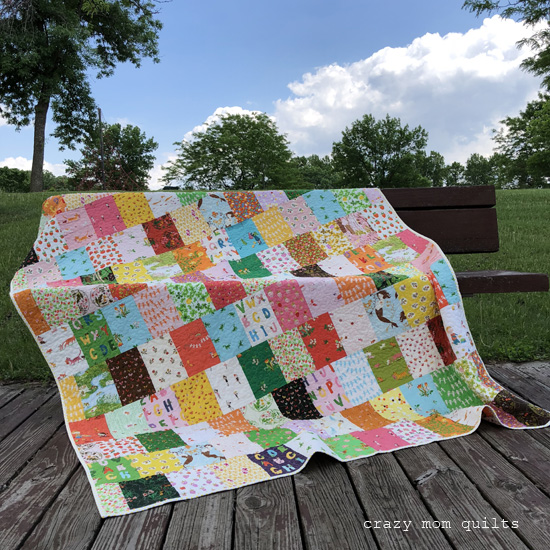Quilt - Easy as Pie
Jun. 3rd, 2018 06:08 pmhttp://crazymomquilts.blogspot.com/2018/06/two-of-kind.html
Pictured - a twin size, measuring about 67 1/2" x 91 (12 blocks x 13 blocks)


Easy as Pie
http://crazymomquilts.blogspot.com/2011/03/easy-as-pie-quilt.html
58" x 70".
about 20+ different fabrics in all
Materials needed:
3 1/4 yards total of various fabrics for the rectangles
1/2 yard for binding
3 1/2 yards backing fabric
60'' x 72'' batting or larger
Cutting:
cut 110 rectangles 5 1/2" x 7 1/2" from various fabrics
cut 10 rectangles 3" x 7 1/2" from various fabrics (these will be referred to as half rectangles)
Assembly:
There are two approaches to the assembly.
The first way is to layout all the blocks at once, making sure that each block is in a specific spot.
The second way is to randomly sew rectangles together to make the rows. Once all the rows are sewn together, they are arranged. This is a much more random approach, but somehow it always seems to work out in the end-especially if you have a large variety of fabrics.
Either way, the rows will be constructed the same way.
Sew 11 rectangles together, side by side. You will be sewing the 7 1/2" sides together, so the rectangles will be standing on end. Add a half rectangle to each row. Make 10 rows.
In every other row, the half rectangle will be the starting block.
In the alternating rows, the half rectangle will be the ending block.
Sew all 10 rows together, making sure to press the seams well. Quilt, baste and bind as desired.
Pictured - a twin size, measuring about 67 1/2" x 91 (12 blocks x 13 blocks)


Easy as Pie
http://crazymomquilts.blogspot.com/2011/03/easy-as-pie-quilt.html
58" x 70".
about 20+ different fabrics in all
Materials needed:
3 1/4 yards total of various fabrics for the rectangles
1/2 yard for binding
3 1/2 yards backing fabric
60'' x 72'' batting or larger
Cutting:
cut 110 rectangles 5 1/2" x 7 1/2" from various fabrics
cut 10 rectangles 3" x 7 1/2" from various fabrics (these will be referred to as half rectangles)
Assembly:
There are two approaches to the assembly.
The first way is to layout all the blocks at once, making sure that each block is in a specific spot.
The second way is to randomly sew rectangles together to make the rows. Once all the rows are sewn together, they are arranged. This is a much more random approach, but somehow it always seems to work out in the end-especially if you have a large variety of fabrics.
Either way, the rows will be constructed the same way.
Sew 11 rectangles together, side by side. You will be sewing the 7 1/2" sides together, so the rectangles will be standing on end. Add a half rectangle to each row. Make 10 rows.
In every other row, the half rectangle will be the starting block.
In the alternating rows, the half rectangle will be the ending block.
Sew all 10 rows together, making sure to press the seams well. Quilt, baste and bind as desired.